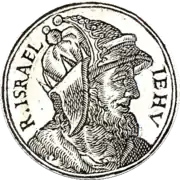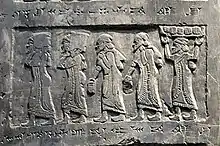Jehu
Jehu (Hebrew: יֵהוּא Yēhū’, meaning "Yahu is He"; Akkadian: 𒅀𒌑𒀀, romanized: Ia-ú-a; Latin: Iehu) was the tenth king of the northern Kingdom of Israel since Jeroboam I, noted for exterminating the house of Ahab. He was the son of Jehoshaphat,[1] grandson of Nimshi, and possibly great-grandson of Omri.[2] His reign lasted for 28 years.
| Jehu | |
|---|---|
 The tribute of "Jehu of the people of the land of Omri" (Akkadian: 𒅀𒌑𒀀 𒈥 𒄷𒌝𒊑𒄿) as depicted on the Black Obelisk of Shalmaneser III | |
| King of Northern Israel | |
| Reign | c. 841–814 BCE |
| Coronation | Ramoth-Gilead, Israel |
| Predecessor | Jehoram |
| Successor | Jehoahaz, his son |
| Died | c. 814 BCE |
| Burial | |
| Issue | Jehoahaz of Israel |
| Father | Jehoshaphat |
William F. Albright has dated his reign to 842–815 BCE, while E. R. Thiele offers the dates 841–814 BCE.[3] The principal source for the events of his reign comes from 2 Kings 9–10.
Proclamation as king

The reign of Jehu's predecessor, Jehoram, was marked by the Battle of Ramoth-Gilead against the army of the Arameans. Jehoram was wounded and returned to Jezreel to recover. He was attended by Ahaziah, king of Judah, who was also his nephew, by his sister Athaliah. Meanwhile, according to the writer of the Book of Kings, the prophet Elisha orders one of his students to go to Ramoth-Gilead and separate Jehu, who was a military commander at the time, from his companions. There, he was to anoint Jehu as king in an inner chamber and explain to him that he was to act as an agent of divine judgement against the house of Ahab. The student followed these instructions and upon completion, he ran away. Jehu initially dismisses the student as being a "madman", but nonetheless tells his companions about his anointing. His companions later enthusiastically blew their trumpets and proclaimed him their king.[4][5]
Jezreel and the deaths of Jehoram and Jezebel

With a chosen band, Jehu planned his conspiracy against King Jehoram and secretly entered Jezreel. King Jehoram tried to flee, but Jehu fired an arrow which pierced his heart. Jehu later threw his body on Naboth's vineyard, to avenge Naboth, whom Jehoram's father and mother had murdered.[6] King Ahaziah fled after seeing Jehoram's death but Jehu wounded him. Ahaziah, nonetheless, managed to flee to Megiddo, where he died.[4]
Jehu proceeded to enter the premises of the palace at Jezreel. Jezebel watched him with contempt from the palace window and mockingly compared him to King Zimri. Jehu later commanded Jezebel's eunuchs to throw her out of the palace window. They obeyed his commands and Jezebel was instantly killed. Jehu trampled over her body but after he decided to arrange a proper burial due to her royal descent, only her skull, hands and feet remained. The rest of her body was eaten by dogs.
Now master of Jezreel, Jehu wrote to command the chief men in Samaria to hunt down and kill all of the royal princes. They did as ordered, and the next day they piled the seventy heads in two heaps outside the city gate, as Jehu commanded. Ahab's entire family was slain. Shortly afterwards, Jehu encountered the forty-two "brothers of Ahaziah" (since the brothers of Ahaziah had previously been taken away and probably killed by the Philistines,[7] these must have been relatives of Ahaziah in a broader sense, like nephews and cousins) at "Beth-eked of the shepherds". They told Jehu that they were visiting the royal family. Jehu, however, killed them all at "the pit of Beth-eked".

Following Jehu's slaughter of the Omrides, he met Jehonadab the Rechabite and convinced him that he was pro-Yahwist. Jehonadab quickly allied with him and they entered the capital together. In control of Samaria, he invited the worshippers of Baal to a ceremony, trapped and killed them.[10] After that, he destroyed their idols and temple, and turned the temple into a latrine.[11]
Other than Jehu's bloody seizure of power and his tolerance for the golden calves at Dan and Bethel (condemned as the "corrupted" version of Yahwism by biblical writers), little else is known of his reign. He was hard pressed by Hazael, king of the Arameans, who defeated his armies "throughout all of the territories of Israel" beyond the Jordan river, in the lands of Gilead, Gad, Reuben, and Manasseh.[12]
This suggests that Jehu offered tribute to Shalmaneser III, as depicted on his Black Obelisk, in order to gain a powerful ally against the Arameans. Bit-Khumri was used by Tiglath-pileser III for the non-Omride kings Pekah (733) & Hoshea (732),[13] hence House/Land/Kingdom of Omri could apply to later Israelite kings not necessarily descended from Omri.
The destruction of the house of Ahab is commended by the author of 2 Kings as a form of divine punishment. Yahweh rewards Jehu for being a willing executor of divine judgement by allowing four generations of kings to sit on the throne of Israel (2 Kings 10:30). Jehu and his descendants Jehoahaz, Jehoash, Jereboam II and Zachariah ruled Israel for 102 years. Nonetheless, according to the Book of Hosea, the House of Jehu was still punished by God through the hands of the Assyrians for Jehu’s massacre at Jezreel.[14]
Black Obelisk

Aside from the Hebrew Scriptures, Jehu appears in Assyrian documents, notably in the Black Obelisk where he is depicted as kissing the ground in front of Shalmaneser III and presenting a gift (maddattu ša Ia-ú-a...kaspu mâdu "tribute of Jehu...much silver"). In the Assyrian documents, he is simply referred to as "son of Omri"[16][17] (Akkadian: mār Ḫumri, possibly expressing his having been the ruler of 'the House of Omri,' a later Assyrian designation for the Kingdom of Israel). This tribute is dated 841 BCE.[18] It is the earliest preserved depiction of an Israelite.[9]
According to the Obelisk, Jehu severed his alliances with Phoenicia and Judah, and became subject to Assyria.

Tel Dan Stele
The author of the Tel Dan Stele (9th century BCE, found in 1993 and 1994) claimed to have slain both Ahaziah of Judah and Jehoram of Israel (whom Ahaziah was visiting). The most likely author of this monument is Hazael of the Arameans.
Sources and notes
- Jehu's father was not the roughly contemporaneous King Jehoshaphat of Judah, whose own father was King Asa of Judah. "Generally Jehu is described as the son only of Nimshi, possibly because Nimshi was more prominent or to avoid confusing him with the King of Judah (R’Wolf)". Scherman, Nosson, ed., "I–II Kings", The Prophets, 297, 2006. See (2 Kings 9:2)
- Amitai Baruchi-Unna, Jehuites, Ahabites, and Omrides: Blood Kinship and Bloodshed, Journal for the Study of the Old Testament 41.1 (2017) pp. 3-21
- Edwin Thiele, The Mysterious Numbers of the Hebrew Kings, (1st ed.; New York: Macmillan, 1951; 2d ed.; Grand Rapids: Eerdmans, 1965; 3rd ed.; Grand Rapids: Zondervan/Kregel, 1983). ISBN 0-8254-3825-X, ISBN 9780825438257
- Driscoll, James F. "Jehu." Catholic Encyclopedia. Vol. 8. New York: Robert Appleton Company, 1910. 7 Jan. 2014
- "2 Kings 9:1-13".
- 1 Kings 21:4
- 2 Chronicles 21:17
- Kuan, Jeffrey Kah-Jin (2016). Neo-Assyrian Historical Inscriptions and Syria-Palestine: Israelite/Judean-Tyrian-Damascene Political and Commercial Relations in the Ninth-Eighth Centuries BCE. Wipf and Stock Publishers. pp. 64–66. ISBN 978-1-4982-8143-0.
- Cohen, Ada; Kangas, Steven E. (2010). Assyrian Reliefs from the Palace of Ashurnasirpal II: A Cultural Biography. UPNE. p. 127. ISBN 978-1-58465-817-7.
- 2 Kings 10:19–10:25
- 2 Kings 10:27
- 2 Kings 10:32
- Kitchen, K A (2003) The Reliability of the Old Testament, Cambridge, Eerdmans, p. 24
- Hosea 1:4–1:5
- Delitzsch, Friedrich; McCormack, Joseph; Carruth, William Herbert; Robinson, Lydia Gillingham (1906). Babel and Bible;. Chicago, The Open court publishing company. p. 78.
- Cuneiform Parallels to the Old Testament - Robert William Rogers
- Bezold, Carl; King, L. W. (1889). Catalogue of the Cuneiform Tablets in the Kouyunjik Collection of the British Museum. British Museum Department of Ancient Egypt and Sudan. ISBN 1145519350.
- Millard, Alan (1997) Discoveries from Bible Times, Oxford, Lion, p. 121
| Wikimedia Commons has media related to Jehu. |